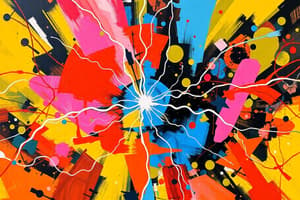Podcast
Questions and Answers
Which materials allow free movement of charged particles making them good conductors of electricity?
Which materials allow free movement of charged particles making them good conductors of electricity?
- Wood and paper
- Plastics and ceramics
- Copper wires and aluminum foils (correct)
- Rubber and glass
What happens to the negative side of a conductor when voltage is applied across it?
What happens to the negative side of a conductor when voltage is applied across it?
- It stays neutral
- It becomes positive (correct)
- It becomes more negative
- Its charge remains the same
What is the term used to describe the energy stored per unit charge between two points?
What is the term used to describe the energy stored per unit charge between two points?
- Electric field strength
- Voltage (correct)
- Magnetic flux
- Resistivity
If electrons move along a wire, what changes according to the voltage?
If electrons move along a wire, what changes according to the voltage?
Which materials restrict the movement of charged particles, preventing electric current flow?
Which materials restrict the movement of charged particles, preventing electric current flow?
What does Coulomb's Law describe about the relationship between two point charges?
What does Coulomb's Law describe about the relationship between two point charges?
How does electric field lines help visualize the behavior of electric charges?
How does electric field lines help visualize the behavior of electric charges?
In Gauss' Law, what quantity must equal the product of the electric constant times the charge enclosed by a closed surface around a single isolated point charge?
In Gauss' Law, what quantity must equal the product of the electric constant times the charge enclosed by a closed surface around a single isolated point charge?
Why does the force described in Coulomb's Law decrease rapidly with increasing distances between point charges?
Why does the force described in Coulomb's Law decrease rapidly with increasing distances between point charges?
What does it mean when field lines cannot cross or intersect each other?
What does it mean when field lines cannot cross or intersect each other?
Flashcards are hidden until you start studying
Study Notes
Electromagnetic Fields
Electric charge and fields involve several fundamental concepts within physics, including conductive materials like metals and non-conducting elements such as plastics. These materials have distinct properties when it comes to carrying electric current, which is crucial to our understanding of electricity. Let us explore these ideas further by examining some key aspects of electric charges and electromagnetic fields.
Electric Charge & Material Properties
Conductors represent those materials where electric charge can move easily; they allow free movement of charged particles inside them, so if you apply voltage across this material, the negative side will become positive with respect to positive side due to the flow of negatively charged electrons from one terminal to another. On the other hand, in insulators, there is a lack of freedom for the motion of charged particles, meaning that even if you apply considerable amounts of voltage, no current will flow through the material. Examples of conductors are copper wires and aluminum foils while insulators might be rubber or glass.
Electric Potential VS Voltage
The term 'potential difference', often called the 'voltage', refers to the energy stored per unit charge between two points. It measures how much potential energy your electron would gain if moved from one point to another. As electrons move along a wire, their energy changes according to voltage. A larger amount of energy implies more voltage. This concept helps us understand why batteries can supply power over time—they store electrical energy, just as water held in a container stores gravitational pull.
Gauss' Law of Electric Flux Density
Gauss' Law was discovered by mathematician Carl Friedrich Gauss during his work on magnetism. It states that the total flux passing through any closed surface around a single isolated point charge must equal the product of the electric constant, ε₀, times the charge enclosed by the surface divided by the distance between the center of the surface and the point charge. Essentially, it quantifies the extent to which electrically charged objects influence each other, allowing scientists to model complex situations involving multiple sources of electric charges.
Coulomb's Law of Attraction Between Two Point Charges
Coulomb's Law tells us that two oppositely charged bodies attract each other, while similarly charged ones repel each other. If two point charges Q₁ and Q₂ are separated by distance r, they exert forces F = K * (Q₁ * Q₂) / r², where K is a proportionality factor known as the electrostatic constant and depends upon the medium surrounding the charges. However, this force decreases rapidly with increasing distances — at 1 cm away, it only has half its original strength, and at 1 meter away, less than a thousandth! Therefore, we rarely notice electromagnetism unless it happens close to home.
Electric Field Lines
Field lines form patterns around electric charges, showing the direction of the force experienced by a small charge placed near it. In general, field lines originate on positively charged areas, end on negatively charged regions, and curve towards lower potential areas. When two charges of opposite sign meet, their field lines merge into a single line. Since field lines cannot cross or intersect each other, they help visualize the behavior of electric charges without running into contradictions.
In summary, electric charge and fields revolve around understanding conductivity, potential differences, laws governing interactions among electric charges, and visualizing these entities using electric field lines. Each concept adds to our comprehension of how matter behaves under various conditions and allows us to predict what could happen next based on existing knowledge.
Studying That Suits You
Use AI to generate personalized quizzes and flashcards to suit your learning preferences.




